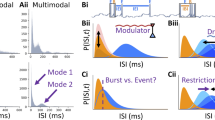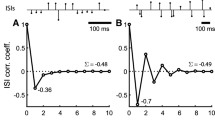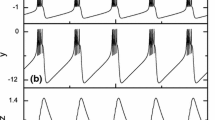Abstract
The functional role of burst firing (i.e. the firing of packets of action potentials followed by quiescence) in sensory processing is still under debate. Should bursts be considered as unitary events that signal the presence of a particular feature in the sensory environment or is information about stimulus attributes contained within their temporal structure? We compared the coding of stimulus attributes by bursts in vivo and in vitro of electrosensory pyramidal neurons in weakly electric fish by computing correlations between burst and stimulus attributes. Our results show that, while these correlations were strong in magnitude and significant in vitro, they were actually much weaker in magnitude if at all significant in vivo. We used a mathematical model of pyramidal neuron activity in vivo and showed that such a model could reproduce the correlations seen in vitro, thereby suggesting that differences in burst coding were not due to differences in bursting seen in vivo and in vitro. We next tested whether variability in the baseline (i.e. without stimulation) activity of ELL pyramidal neurons could account for these differences. To do so, we injected noise into our model whose intensity was calibrated to mimic baseline activity variability as quantified by the coefficient of variation. We found that this noise caused significant decreases in the magnitude of correlations between burst and stimulus attributes and could account for differences between in vitro and in vivo conditions. We then tested this prediction experimentally by directly injecting noise in vitro through the recording electrode. Our results show that this caused a lowering in magnitude of the correlations between burst and stimulus attributes in vitro and gave rise to values that were quantitatively similar to those seen under in vivo conditions. While it is expected that noise in the form of baseline activity variability will lower correlations between burst and stimulus attributes, our results show that such variability can account for differences seen in vivo. Thus, the high variability seen under in vivo conditions has profound consequences on the coding of information by bursts in ELL pyramidal neurons. In particular, our results support the viewpoint that bursts serve as a detector of particular stimulus features but do not carry detailed information about such features in their structure.









Similar content being viewed by others
References
Arganda, S., Guantes, R., & de Polavieja, G. G. (2007). Sodium pumps adapt spike bursting to stimulus statistics. Nature Neuroscience, 10, 1467–1473.
Avila Akerberg, O., Krahe, R., & Chacron, M. J. (2010). Neural heterogeneities and stimulus properties affect burst coding in vivo. Neuroscience, 168, 300–313.
Bastian, J., & Nguyenkim, J. (2001). Dendritic Modulation of Burst-like firing in sensory neurons. Journal of Neurophysiology, 85, 10–22.
Bastian, J., Chacron, M. J., & Maler, L. (2002). Receptive field organization determines pyramidal cell stimulus-encoding capability and spatial stimulus selectivity. The Journal of Neuroscience, 22, 4577–4590.
Bastian, J., Chacron, M. J., & Maler, L. (2004). Plastic and non-plastic cells perform unique roles in a network capable of adaptive redundancy reduction. Neuron, 41, 767–779.
Berman, N. J., & Maler, L. (1998). A inhibition evoked from primary afferents in the electrosensory lateral line lobe of the weakly electric fish (Apteronotus leptorhynchus). Journal of Neurophysiology, 80, 3173–3196.
Berman, N. J., & Maler, L. (1999). Neural architecture of the electrosensory lateral line lobe: adaptations for coincidence detection, a sensory searchlight and frequency-dependent adaptive filtering. The Journal of Experimental Biology, 202, 1243–1253.
Bullock, T. H., Hopkins, C. D., Popper, A. N., & Fay, R. R. (2005). Electroreception. New York: Springer.
Chacron, M. J. (2006). Nonlinear information processing in a model sensory system. Journal of Neurophysiology, 95, 2933–2946.
Chacron, M. J., & Bastian, J. (2008). Population coding by electrosensory neurons. Journal of Neurophysiology, 99, 1825–1835.
Chacron, M. J., Doiron, B., Maler, L., Longtin, A., & Bastian, J. (2003). Non-classical receptive field mediates switch in a sensory neuron’s frequency tuning. Nature, 423, 77–81.
Chacron, M. J., Longtin, A., & Maler, L. (2004). To burst or not to burst? J Comp Neurosci, 17, 127–136.
Chacron, M. J., Lindner, B., & Longtin, A. (2004). Noise shaping by interval correlations increases information transfer. Physical Review Letters, 92, 080601.
Chacron, M. J., Maler, L., & Bastian, J. (2005a). Feedback and feedforward control of frequency tuning to naturalistic stimuli. The Journal of Neuroscience, 25, 5521–5532.
Chacron, M. J., Longtin, A., & Maler, L. (2005b). Delayed excitatory and inhibitory feedback shape neural information transmission. Physical Review E, 72, 051917.
Chacron, M. J., Maler, L., & Bastian, J. (2005c). Electroreceptor neuron dynamics shape information transmission. Nature Neuroscience, 8, 673–678.
Chacron, M. J., Lindner, B., Longtin, A., Maler, L., & Bastian, J. (2005d). Experimental and Theoretical demonstration of noise shaping by interspike interval correlations. Proceedings of SPIE, 5841, 150–163.
Chacron, M. J., Lindner, B., & Longtin, A. (2007). Threshold fatigue and information transfer. J Comp Neurosci, 23, 301–311.
Chacron, M. J., Toporikova, N., & Fortune, E. S. (2009). Differences in the time course of short-term depression across receptive fields are correlated with directional selectivity in electrosensory neurons. Journal of Neurophysiology, 102, 3270–3279.
Dayan, P., & Abbott, L. F. (2001). Theoretical neuroscience: Computational and mathematical modeling of neural systems. Cambridge: MIT Press.
Dean, A. F. (1981). The variability of discharge of simple cells in the cat striate cortex. Experimental Brain Research, 44, 437–440.
DeBusk, B. C., DeBruyn, E. J., Snider, R. K., Kabara, J. F., & Bonds, A. B. (1997). Stimulus-dependent modulation of spike burst length in cat striate cortical cells. Journal of Neurophysiology, 78, 199–213.
Destexhe, A., & Paré, D. (1999). Impact of Network activity on the integrative properties of neocortical pyramidal neurons in vivo. Journal of Neurophysiology, 81, 1531–1547.
Destexhe, A., Rudolph, M., Fellous, J. M., & Sejnowski, T. J. (2001). Fluctuating synaptic conductances recreate in vivo-like activity in neocortical neurons. Neuroscience, 107, 13–24.
Destexhe, A., Rudolph, M., & Pare, D. (2003). The high-conductance state of neocortical neurons in vivo. Nature Reviews. Neuroscience, 4, 739–751.
Doiron, B., Laing, C., Longtin, A., & Maler, L. (2002). Ghostbursting: a novel neuronal burst mechanism. Journal of Computational Neuroscience, 12, 5–25.
Doiron, B., Oswald, A. M., & Maler, L. (2007). Interval coding. II. Dendrite-dependent mechanisms.[see comment]. Journal of Neurophysiology, 97, 2744–2757.
Ellis, L. D., Krahe, R., Bourque, C. W., Dunn, R. J., & Chacron, M. J. (2007). Muscarinic receptors control frequency tuning through the downregulation of an A-type potassium current. Journal of Neurophysiology, 98, 1526–1537.
Ellis, L. D., Mehaffey, W. H., Harvey-Girard, E., Turner, R. W., Maler, L., & Dunn, R. J. (2007). SK channels provide a novel mechanism for the control of frequency tuning in electrosensory neurons. The Journal of Neuroscience, 27, 9491–9502.
Eyherabide, H. G., Rokem, A., Herz, A. V., & Samengo, I. (2008). Burst firing is a neural code in an insect auditory system. Front Comput Neurosci, 2, 3.
Fortune, E. S., & Rose, G. (1997). Passive and active membrane properties contribute to the temporal filtering properties of midbrain neurons in vivo. The Journal of Neuroscience, 17, 3815–3825.
Frank, K., & Becker, M. C. (1964). Microelectrodes for recording and stimulation. In L. Nastuk (Ed.), Physical techniques in biological research, Vol. V, Part A (pp. 22–87). New York: Academic Press.
Gabbiani, F., & Koch, C. (1996). Coding of time-varying signals in spike trains of integrate-and-fire neurons with random threshold. Neural Computation, 8, 44–66.
Gabbiani, F., Metzner, W., Wessel, R., & Koch, C. (1996). From stimulus encoding to feature extraction in weakly electric fish. Nature, 384, 564–567.
Gaudry, K. S., & Reinagel, P. (2008). Information measure for analyzing specific spiking patterns and applications to LGN bursts. Network, 19, 69–94.
Hitschfeld, E. M., Stamper, S. A., Vonderschen, K., Fortune, E. S., & Chacron, M. J. (2009). Effects of restraint and immobilization on electrosensory behaviors of weakly electric fish. ILAR Journal, 50, 361–372.
Izhikevich, E. M. (2000). Neural Excitability, spiking, and bursting. International Journal of Bifurcations and Chaos, 10, 1171–1269.
Izhikevich, E. M., Desai, N. S., Walcott, E. C., & Hoppensteadt, F. C. (2003). Bursts as a unit of neural information: selective communication via resonance. Trends in Neurosciences, 26, 161–167.
Jones, L. M., Lee, S., Trageser, J. C., Simons, D. J., & Keller, A. (2004). Precise temporal responses in whisker trigeminal neurons. Journal of Neurophysiology, 92, 665–668.
Kepecs, A., Wang, X. J., & Lisman, J. (2002). Bursting neurons signal input slope. The Journal of Neuroscience, 22, 9053–9062.
Kloeden, P. E., & Platen, E. (1999). Numerical solutions of stochastic differential equations. Berlin: Springer.
Krahe, R., & Gabbiani, F. (2004). Burst firing in sensory systems. Nature Reviews. Neuroscience, 5, 13–23.
Krahe, R., Bastian, J., & Chacron, M. J. (2008). Temporal processing across multiple topographic maps in the electrosensory system. Journal of Neurophysiology, 100, 852–867.
Lemon, N., & Turner, R. W. (2000). Conditional spike backpropagation generates burst discharge in a sensory neuron. Journal of Neurophysiology, 84, 1519–1530.
Lesica, N. A., & Stanley, G. B. (2004). Encoding of natural scene movies by tonic and burst spikes in the lateral geniculate nucleus. The Journal of Neuroscience, 24, 10731–10740.
Lindner, B., Chacron, M. J., & Longtin, A. (2005). Integrate-and-fire neurons with threshold noise: a tractable model of how interspike interval correlations affect neuronal signal transmission. Physical Review. E, 72, 021911.
Lisman, J. E. (1997). Bursts as a unit of neural information: making unreliable synapses reliable. Trends in Neurosciences, 20, 38–43.
Mainen, Z. F., & Sejnowski, T. J. (1995). Reliability of spike timing in neocortical neurons. Science, 268, 1503–1506.
Manwani, A., & Koch, C. (1999). Detecting and estimating signals in noisy cable structure, I: neuronal noise sources. Neural Computation, 11, 1797–1829.
Marsat, G., & Maler, L. (2010). Neural heterogeneity and efficient population codes for communication signals. Journal of Neurophysiology, 104, 2543–2555.
Marsat, G., & Pollack, G. S. (2006). A behavioral role for feature detection by sensory bursts. The Journal of Neuroscience, 26, 10542–10547.
Marsat, G., & Pollack, G. S. (2010). The structure and size of sensory bursts encode stimulus information but only size affects behavior. Journal of Comparative Physiology. A: Neuroethology, Sensory, Neural, and Behavioral Physiology, 196, 315–320.
Marsat, G., Proville, R. D., & Maler, L. (2009). Transient signals trigger synchronous bursts in an identified population of neurons. Journal of Neurophysiology, 102, 714–723.
Martinez-Conde, S., Macknik, S. L., & Hubel, D. H. (2002). The function of bursts of spikes during visual fixation in the awake primate lateral geniculate nucleus and primary visual cortex. Proceedings of the National Academy of Sciences of the United States of America, 99, 13920–13925.
Mayer, M. L., & Westbrook, G. L. (1987). Permeation and block of N-methyl-D-aspartic acid receptor channels by divalent cations in mouse cultured central neurones. Journal de Physiologie, 394, 501–527.
Mehaffey, W. H., Maler, L., & Turner, R. W. (2008). Intrinsic frequency tuning in ELL pyramidal cells varies across electrosensory maps. Journal of Neurophysiology, 99, 2641–2655.
Mehaffey, W. H., Ellis, L. D., Krahe, R., Dunn, R. J., & Chacron, M. J. (2008). Ionic and neuromodulatory regulation of burst discharge controls frequency tuning. Journal of Physiology - Paris, 102, 195–208.
Metzner, W., & Juranek, J. (1997). A sensory brain map for each behavior? PNAS, 94, 14798–14803.
Metzner, W., Koch, C., Wessel, R., & Gabbiani, F. (1998). Feature extraction by burst-like spike patterns in multiple sensory maps. The Journal of Neuroscience, 18, 2283–2300.
Noonan, L., Doiron, B., Laing, C., Longtin, A., & Turner, R. W. (2003). A dynamic dendritic refractory period regulates burst discharge in the electrosensory lobe of weakly electric fish. The Journal of Neuroscience, 23, 1524–1534.
Nowak, L., Bregestovski, P., Ascher, P., Herbet, A., & Prochiantz, A. (1984). Magnesium gates glutamate-activated channels in mouse central neurones. Nature, 307, 462–465.
Oswald, A. M. M., Chacron, M. J., Doiron, B., Bastian, J., & Maler, L. (2004). Parallel processing of sensory input by bursts and isolated spikes. The Journal of Neuroscience, 24, 4351–4362.
Oswald, A. M., Doiron, B., & Maler, L. (2007). Interval coding. I. Burst interspike intervals as indicators of stimulus intensity.[see comment]. Journal of Neurophysiology, 97, 2731–2743.
Reynolds, I. J., & Miller, R. J. (1990). Allosteric modulation of N-methyl-D-aspartate receptors. Advances in Pharmacology, 21, 101–126.
Rinzel, J. (1987). A formal classification of bursting mechanisms in excitable systems. In E. Teramoto & M. Yamaguti (Eds.), Mathematical Topics in Population Biology, Morphogenesis and Neurosciences, Lecture Notes in Biomathematics 71 (pp. 267–281). New York: Springer-Verlag.
Sadeghi, S. G., Chacron, M. J., Taylor, M. C., & Cullen, K. E. (2007). Neural variability, detection thresholds, and information transmission in the vestibular system. The Journal of Neuroscience, 27, 771–781.
Samengo, I., & Montemurro, M. A. (2010). Conversion of phase information into a spike-count code by bursting neurons. PLoS ONE, 5, e9669.
Sherman, S. M. (2001). Tonic and burst firing: dual modes of thalamocortical relay. Trends in Neurosciences, 24, 122–126.
Sherman, S. M., & Guillery, R. W. (2002). The role of the thalamus in the flow of information to the cortex. Philosophical Transactions of the Royal Society of London. Series B: Biological Sciences, 357, 1695–1708.
Shumway, C. (1989). Multiple electrosensory maps in the medulla of weakly electric Gymnotiform fish. II. Anatomical differences. Journal of Neuroscience, 9, 4400–4415.
Stein, R. B., Gossen, E. R., & Jones, K. E. (2005). Neuronal variability: noise or part of the signal? Nature Reviews. Neuroscience, 6, 389–397.
Theunissen, F., & Miller, J. P. (1995). Temporal encoding in the nervous system: a rigorous definition. Journal of Computational Neuroscience, 2, 149–162.
Tolhurst, D. J., Movshon, J. A., & Dean, A. F. (1983). The statistical reliability of signals in single neurons in cat and monkey visual cortex. Vision Research, 23, 775–785.
Toporikova, N., & Chacron, M. J. (2009). Dendritic SK channels gate information processing in vivo by regulating an intrinsic bursting mechanism seen in vitro. Journal of Neurophysiology, 102, 2273–2287.
Turner, R. W., Maler, L., Deerinck, T., Levinson, S. R., & Ellisman, M. H. (1994). TTX-sensitive dendritic sodium channels underlie oscillatory discharge in a vertebrate sensory neuron. The Journal of Neuroscience, 14, 6453–6471.
Wagner, J., & Keizer, J. (1994). Effects of rapid buffers on Ca2+ diffusion and Ca2+ oscillations. Biophysical Journal, 67, 447–456.
Wang, X. J., & Rinzel, J. (1995). Oscillatory and bursting properties of neurons. In M. A. Arbib (Ed.), The handbook of brain theory and neural networks (pp. 686–691). Cambridge: MIT Press.
Wolfart, J., Debay, D., Le Masson, G., Destexhe, A., & Bal, T. (2005). Synaptic background activity controls spike transfer from thalamus to cortex. Nature Neuroscience, 8, 1760–1767.
Acknowledgements
This research was supported by CONACYT (O.A.A.) and CIHR, CFI, and CRC (M.J.C).
Author information
Authors and Affiliations
Corresponding author
Additional information
Action Editor: Brent Doiron
Rights and permissions
About this article
Cite this article
Akerberg, O.A., Chacron, M.J. In vivo conditions influence the coding of stimulus features by bursts of action potentials. J Comput Neurosci 31, 369–383 (2011). https://doi.org/10.1007/s10827-011-0313-4
Received:
Revised:
Accepted:
Published:
Issue Date:
DOI: https://doi.org/10.1007/s10827-011-0313-4




